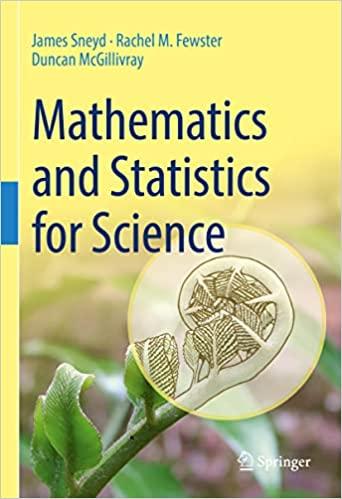The menstrual rhythm, with a period of close to a month (at least in humans), is another
Question:
The menstrual rhythm, with a period of close to a month (at least in humans), is another critical physiological rhythm, and female body temperature fluctuates on a monthly cycle. However, these Although the word "menstrual" is derived from the Latin word "mensis"
(month), and the Greek word "mene"
(moon), human menstrual cycles are only approximately the same length as the lunar month, and there is no good evidence that menstrual cycles synchronise with lunar cycles.
fluctuations in body temperature occur at the same time as the circadian body temperature rhythm (with a period of a day),
and so the body temperature in females is a complex pattern that results from two interacting oscillations.
A typical example is shown in Fig. 5.22. You can clearly see the circadian rhythm, as the core body temperature goes up and down on a daily basis. However, the midpoint of these circadian fluctuations also oscillates, but with a much longer period of around 28 days.
How could you model the temperature, T, using trig functions?
Well, the circadian rhythm could be modelled as a cosine or sine function, as we’ve done with other examples in this chapter, and so you could put T = Tm + Acos(kt), and then determine Tm, A and k approximately from the first few oscillations in the data.
Remember that, in this equation, Tm is the midpoint of the oscillation.
However, you then need to make the midpoint go up and down, and so you could set Tm = Taverage + Am cos(kmt), and then determine Am and km by making the menstrual oscillation go up and down at the correct rate and amplitude.
This, then, is your mission (should you choose to accept it).
Determine all those parameters from Fig. 5.22 and plot the result. Basically, you just do this by trial and error. Make initial guesses by looking at the graph, plot the result, and then adjust your guesses to make your curves look better. Here are some hints:
a. Do the circadian rhythm first. Fix Tm to be a sensible constant (37.2 oC looks good, for example) and put t in the units of days, so that the circadian cycle has period 1.
Then, k will be 2π/day. A will then be around 0.4 oC or so.
The midpoint of all the oscillations is shown on the graph, as a dashed line at 37.2 oC.
b. Next, do the menstrual rhythm. Taverage will probably be close to 37.2 oC, but km will be quite different from k.
In order to get a period of 28 days, you need to choose km around 2π/28/day. Then fiddle around Am until the menstrual oscillation has about the correct amplitude.
Step by Step Answer:

Mathematics And Statistics For Science
ISBN: 9783031053177
1st Edition
Authors: James Sneyd, Rachel M. Fewster, Duncan McGillivray





